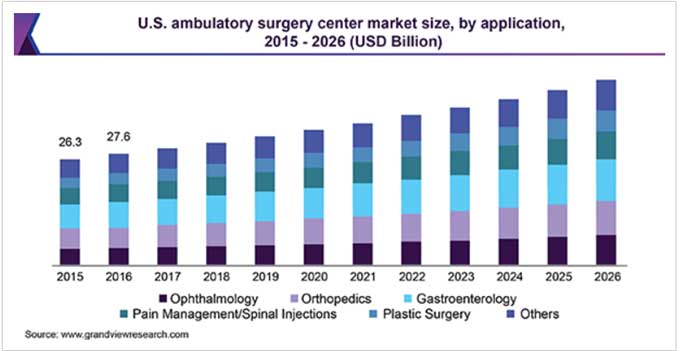If you’re interested in investing in medical technology companies (MedTech), there’s a fast moving market segment that could present the biggest opportunity for high-speed growth this decade…
They’re called Ambulatory Surgical Center’s (ASC for short). And they’re a $75 billion global market that’s projected to skyrocket to $120 billion by 2026.
What’s driving the growth of this red-hot market? Here are a few major factors.
- Convenience and Cost Savings
Hospitals are great, but they are bureaucratic nightmares and incredibly expensive.
According to Cath Lab Digest, ASCs are typically able to streamline the registration, admission, and discharge processes.
If you have a patient who can go to ASC, the patient, insurance carrier, and doctor wants them to go there.
Why? Because it’s an outpatient center vs inpatient center.
The result is the patient spends much less time at the facility on the day of the procedure. Compared to hospitals, the magazine notes that:
“The convenience seems to far surpass that of hospital registration and pre-surgical processes.”
Then there’s the cost factor. A paper in the Journal of Spine Surgery found that the cost of performing a surgical procedure in an ASC is 45% to 47% lower compared to hospitals.
This “cost gap” has only been increasing.
In 2003, Medicare paid hospitals only 16% more, on average, than it paid ASCs for the same procedure. In 2019, Medicare paid hospitals 82% more than ASCs for outpatient surgery.
And last but not least, people want to have the shiny new personal service you get from an ASC wherever possible.
- Increasing Demand for Minimally Invasive Surgeries – Especially Spinal Surgeries
People don’t want to have a giant incision in their back, have a bad anesthesia reaction, or have other complications.
Minimally invasive surgery gives them the option of having a safer, faster, and cheaper procedure that leaves less scarring and shorter recovery periods.
This is especially true for patients interested in spinal surgeries – a procedure which drives 20% to 25% of their orthopedic procedures but contributes over 50% to the profit.
If spinal surgeries were made safer, the demand for spinal surgeries at ASCs could surge.
But there’s a problem when it comes to pushing the market forward: Technology and training.
While we’re starting to see some impressive advancements in robotic surgical devices, we haven’t reached a point where all things can be easily (and safely) roboticized.
And then there’s training. According to a review of minimally invasive surgery utilization rates in the US:
“Residents and fellows learn in an apprenticeship model, yet for many, the surgeons they learn from may lack advanced skills in minimally invasive surgery.
Fortunately, the popularity of minimally invasive surgery has created demand for more training programs for surgeons.
- The COVID-19 Amplifier
The rise of ASCs has been going on for the past decade, but COVID-19 threw jet fuel onto the market’s growth prospects.
Why?
People didn’t want to go to hospitals for fear of getting exposure to COVID-19.
The fear of contracting COVID-19 is driving patients away from hospitals and towards ASCs, with a survey finding that 46.2% of people claim that they would request the surgery take place at an ASC instead of a hospital.
As Dan Murrey, MD, chief medical officer of Surgical Care Affiliates in Deerfield, Illinois, said in a June 2020 interview, patients who have had their elective procedures halted due to the pandemic are now “anxious to have surgery done.”
The result is surgery centers are overwhelmed with spinal business.
But the problem?
Many physicians are not equipped to do their practices in surgery centers.
And the only logical way to meet this increased demand is to arm surgeons with better tools that make it easier – and safer – to perform minimally invasive surgeries .
The bottom line? This is a perfect opportunity for companies that have a product geared towards ASC (Ambulatory Surgery Center).
Sincerely,
Jake Hoffberg – Publisher
Equifund














